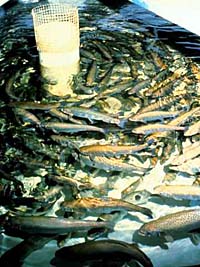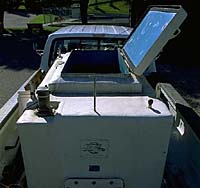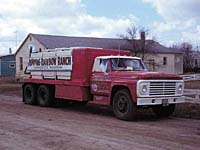

Before station stock are distributed to provincial waterbodies, their weight and numbers are recorded so that the receiving waterbody will not be overstocked. A lake or any other waterbody has a finite carrying capacity which means that it is capable of supporting only a certain number of fish. If there are too many fish placed in the waterbody, their need for food and oxygen may be more than the waterbody is capable of providing and some of the fish may perish. Placing too large a number in a waterbody can present as many problems as having too few. |

The manner in which station stock are distributed may vary depending on the species and the stage in their life cycle the stock have reached. As an example, walleye and whitefish fry make the journey from the station to their new homes in water-filled plastic tubes of five-gallon capacity. These containers are oxygen 'charged' and can hold as many as 50,000 walleye fry or 35,000 whitefish fry for up to 12 hours. Trout fingerlings are transported in water-filled tanks which may range in size from 40 to 350 gallons. The tanks are aerated and well-insulated so the water temperature remains constant during transport. The 350 gallon tank holds as many as 35,000 trout fingerlings. The smaller tanks can carry between 3000 to 5000 fingerlings, depending on the age of the fingerlings and their size. |

The vast majority of distribution is carried out by truck. Some remote northern lakes are only accessible by air and so these lakes are stocked by plane or helicopter. The majority of waterbodies anywhere in the province can be stocked within 12 hours from the time the stock leaves the station. Even areas as far north as Lake Athabasca in the northwest corner of the province can be stocked on the same day as the shipment leaves the station. A final function of the station is to provide information to the public on the operation of the station and its role in meeting provincial fisheries management goals.
|